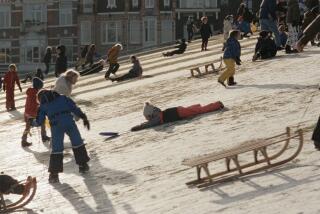Frankfurt Divided Over Ways to Preserve Remains of 15th-Century Jewish Ghetto
- Share via
FRANKFURT, West Germany — The city government is embroiled in a dispute over how to preserve in downtown Frankfurt what remains of a Jewish ghetto that dates to the 15th Century.
The controversy already has led to a protest at the site where city officials plan to remove old building foundations of the ghetto to make way for a city administration building.
Frankfurt was a vital Jewish center for centuries before the Nazi period. Jews such as 18th-Century banker Meyer Amschel Rothschild were prominent in city life. The city now has the most prominent Jewish community in West Germany, and more than a third of its 5,000 members are under age 40.
In dispute are Mayor Wolfram Brueck’s plans to preserve the foundations of only five of 19 buildings that were part of the ghetto, as an annex to the city’s Jewish museum due to open in the area next year.
‘Bits of Stone’
“The city will preserve the most intact foundations on the site,” Stefan Lauer, spokesman for Brueck, said. “The other remains are just bits of stone.”
However, a group of citizens, led by the leftist Greens political and environment organization and the opposition Social Democrats joined by Christian groups, has turned the ghetto site into a major testing ground for the city’s efforts to preserve its Jewish heritage.
They contend that the Christian Democratic mayor’s plan is not enough.
“This whole area could be a monument to Judaism in Frankfurt today,” said Manon Tuckfeld, a representative of the Greens in city government. “It’s the Germans’ responsibility to preserve as much of Jewish life here as possible.”
Open-Air Monument
He maintains that the entire site should be preserved as an open-air cultural monument. The site, roughly a block long, is now torn up, in part for the new city administration building and in part for archeological excavations.
Protesters occupied the site on Aug. 27 and left peacefully on Sept. 2 on orders from the police.
“We don’t want any violence,” said Roland Frischkorn, a City Council member of the Social Democratic Party. “The ghetto site is a place of reflection.”
Leaders of the Jewish community, while not at the forefront of the protest, have indicated their reservations about Brueck’s plan.
Questions Remain
“We negotiated with the city many times over the ghetto site,” said the community’s chairman, Ignatz Bubis. “We’re pleased about the museum and the open square that will be built next to it, extending to the (700-year-old) Jewish cemetery.”
But Bubis said the community still has questions about the number of foundations to be saved.
“The last word has not yet been spoken,” he said.
The stone foundations, the only remnants of Jewish ghetto buildings left in West Germany, were once the basements of private homes.
Archeological Search
“Most of the cellar walls are from the 18th Century, but archeologists are hoping to find older remains underneath them,” Michael Lenarz of the Jewish Museum said.
Archeologists also found the remains of a mikvah, or bath, used by Jews for ritual purification starting in the late Middle Ages. The city has agreed to leave the mikvah in place as part of the museum exhibit.
The first ghetto houses were built by city officials in 1462, at a time when Jews in several European cities were forced to live apart from their Christian neighbors.
By the end of the 19th Century, city officials had torn down the houses in the ghetto and Jews were allowed to live wherever they pleased. A synagogue remained there, however, until the Nazis destroyed it 50 years ago.
Nearly 30,000 Jews lived in Frankfurt before the Nazis took power in Germany.
More to Read
Sign up for Essential California
The most important California stories and recommendations in your inbox every morning.
You may occasionally receive promotional content from the Los Angeles Times.













